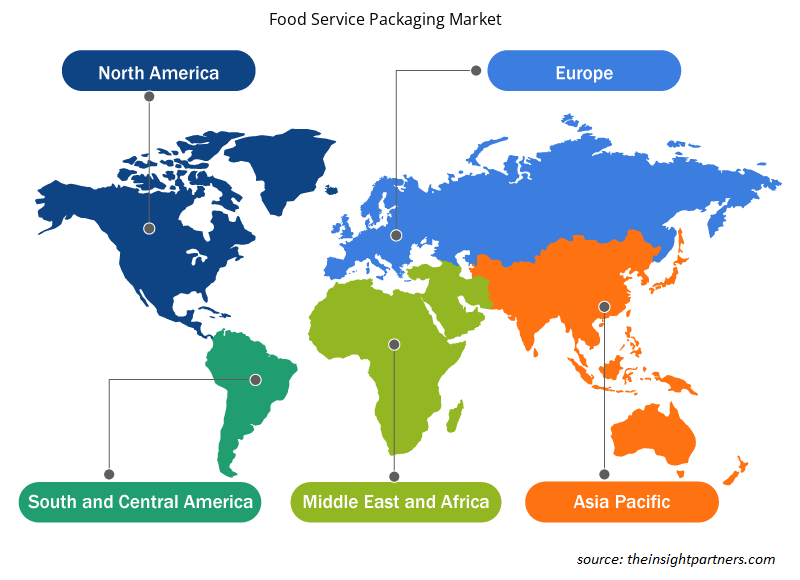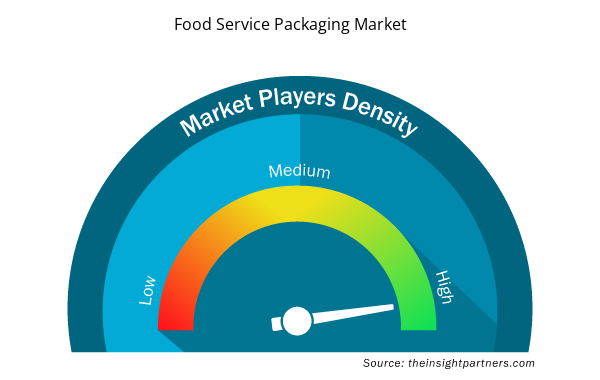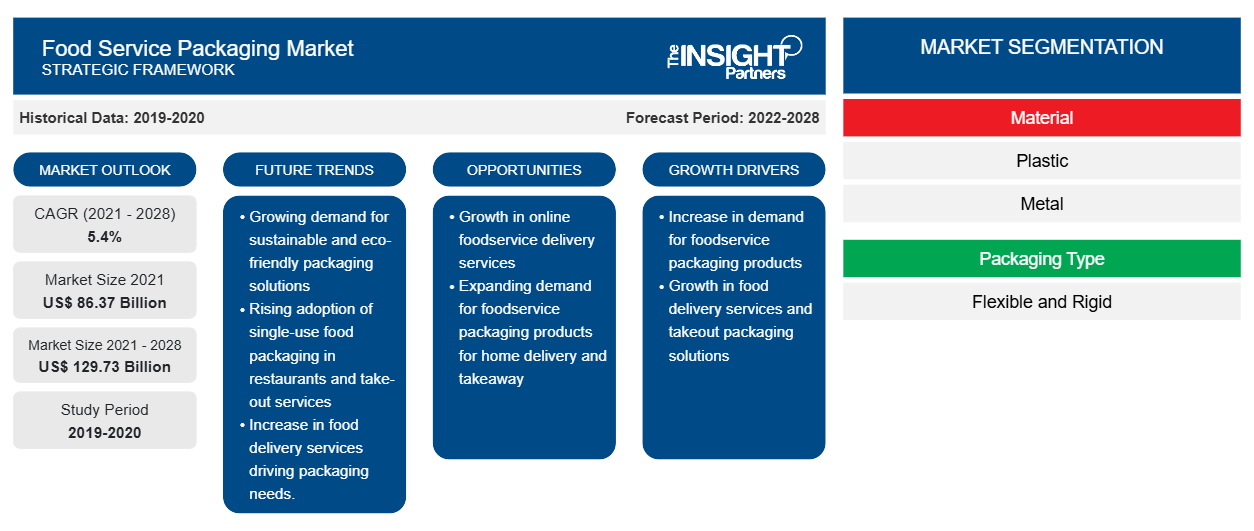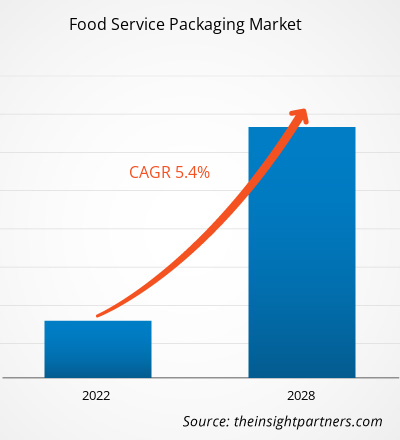[Forschungsbericht] Der Markt für Lebensmittelverpackungen wurde im Jahr 2021 auf 86.372,08 Millionen US-Dollar geschätzt und soll bis 2028 129.728,93 Millionen US-Dollar erreichen; es wird erwartet, dass er von 2021 bis 2028 mit einer durchschnittlichen jährlichen Wachstumsrate von 5,4 % wächst.CAGR of 5.4% from 2021 to 2028.
Verpackungen für den Lebensmittelservice umfassen Produkte, die zum Servieren oder Verpacken von zubereiteten Speisen und Getränken in Restaurants, zum Mitnehmen und bei der Lieferung nach Hause verwendet werden. Zu den Verpackungsprodukten für den Lebensmittelservice gehören Becher, Teller, Tabletts, Schüsseln, Beutel (für Einzelportionen und zum Mitnehmen), Behälter und Deckel, Besteck und Besteck, Eisbecher, Suppenbecher und Getränketräger. Diese Produkte schützen die Lebensmittel vor Verunreinigungen durch Mikroorganismen, Luft und Feuchtigkeit.
Im Jahr 2020 hatte der asiatisch-pazifische Raum den größten Umsatzanteil am globalen Markt für Lebensmittelverpackungen . Die hohe Nachfrage nach Lebensmittelverpackungen von Full-Service-Restaurants, Cafés usw. treibt den Markt für Lebensmittelverpackungen im asiatisch-pazifischen Raum hauptsächlich an. Die Online-Bestellung von Lebensmitteln nimmt in der Region aufgrund der Bequemlichkeit zu, die diese Plattformen bieten, was auch eine enorme Nachfrage nach verschiedenen Lebensmittelverpackungen schafft. China und Indien gehören zu den wichtigsten Ländern im asiatisch-pazifischen Raum für den Markt. In Indien treibt der wachsende Trend der städtischen Bevölkerung, auswärts zu essen, das Marktwachstum im Land an.
Passen Sie diesen Bericht Ihren Anforderungen an
Sie erhalten kostenlose Anpassungen an jedem Bericht, einschließlich Teilen dieses Berichts oder einer Analyse auf Länderebene, eines Excel-Datenpakets sowie tolle Angebote und Rabatte für Start-ups und Universitäten.
- Holen Sie sich die wichtigsten Markttrends aus diesem Bericht.Dieses KOSTENLOSE Beispiel umfasst eine Datenanalyse von Markttrends bis hin zu Schätzungen und Prognosen.
Auswirkungen der COVID-19-Pandemie auf den Markt für Food-Service-Verpackungen
Die COVID-19-Pandemie beeinträchtigte die Wirtschaft und Industrie in verschiedenen Ländern durch Lockdowns, Reiseverbote und Betriebsschließungen. Im Jahr 2020 mussten verschiedene Branchen ihren Betrieb aufgrund von Störungen in den Wertschöpfungsketten, die durch die Schließung nationaler und internationaler Grenzen verursacht wurden, verlangsamen. Die Pandemie störte die Herstellungsprozesse aufgrund von Beschränkungen, die von Regierungsbehörden in verschiedenen Ländern verhängt wurden. Die rasche Ausbreitung von COVID-19 stellte die Lebensmittelindustrie vor beispiellose Herausforderungen. Die Schließung von Restaurants, Bars und Clubs aufgrund von Maßnahmen zur sozialen Distanzierung in verschiedenen Ländern auf der ganzen Welt hat sich negativ auf die Nachfrage nach Verpackungsprodukten für Lebensmittelservices ausgewirkt.
Der zunehmende Verkauf von Essen zum Mitnehmen und Online-Bestellungen von Speisen hat jedoch Chancen für Restaurants geschaffen. Die Wirtschaft begann 2021 mit der Wiederbelebung ihres Betriebs. Mit der Eröffnung von Restaurants, Bars, Clubs und anderen Gastronomiebetrieben steigt die Nachfrage nach verschiedenen Verpackungsprodukten für die Gastronomie weiter an.
Markteinblicke
Anstieg der Produktionskapazität von Verpackungsprodukten
Das steigende Interesse der Verbraucher am Verzehr frischer Produkte mit längerer Haltbarkeit und kontrollierter Qualität führt zu einer Nachfrage nach Lebensmittelverpackungen. Dieser Faktor hilft Lebensmittelverpackungsherstellern bei der Entwicklung und Gestaltung neuer und sicherer Verpackungen. Darüber hinaus übt die wachsende Bevölkerung zusätzlichen Druck auf die Lebensmittelproduktionsbranchen aus, verbesserte Verpackungslösungen einzuführen, um Lebensmittelabfälle zu reduzieren. Daher zielt der aktuelle Ansatz zur Verbesserung der Lebensmittelindustrie darauf ab, Lebensmittelschäden und -abfälle durch wichtige Investitionen in die Entwicklung neuartiger und innovativer Technologien für Lebensmittelverpackungen zu verringern.
Materialeinblicke
Basierend auf dem Material wurde der globale Markt für Lebensmittelverpackungen in Kunststoff, Metall und andere unterteilt. Das Kunststoffsegment hatte im Jahr 2020 den größten Anteil am globalen Markt für Lebensmittelverpackungen. Kunststoffverpackungen sind eine flexible Verpackungsform. Sie ermöglichen es Lebensmitteldienstleistern, Form, Stil und Größe der Verpackung entsprechend den Anforderungen ihrer Kunden anzupassen. Kunststoffverpackungen werden in der Lebensmittelindustrie bevorzugt, da sie leicht sind. Diese Vorteile von Kunststoffverpackungen haben Kunden aus der Lebensmittelindustrie angezogen. Daher erlebt der Markt für Kunststoffverpackungen für Lebensmittel einen Aufschwung.
Anwendungseinblicke
Basierend auf der Anwendung wurde der globale Markt in Getränke, Fertiggerichte, Obst und Gemüse, Back- und Süßwaren, Milchprodukte und andere unterteilt
.
Das Segment Fertiggerichte hatte im Jahr 2020 den größten Anteil am weltweiten Markt für Verpackungen für Foodservice-Anwendungen. Für die Verpackung von Fertiggerichten werden biobasierte und biologisch abbaubare Kunststoffe und Aluminium verwendet. Zum Einsatz kommen Schalenversiegelung, Thermoformen, Standbeutel, Retortenverpackungen und -beutel, selbsterhitzende Dosen und Stretchfolien, mit denen die Verpackungspräsentation der Lebensmittel individuell gestaltet werden kann.
Graphic Packaging International, LLC; Amcor PLC; Cambay Technopack Private Limited; Huhtamaki Global; AR Packaging; WestRock Company; Genpak, LLC; Vegware Ltd; BeGreen Packaging; und Stora Enso gehören zu den wichtigsten Akteuren auf dem globalen Markt für Lebensmittelverpackungen. Akteure auf dem globalen Markt für Lebensmittelverpackungen konzentrieren sich ständig auf Strategien wie Investitionen in Forschungs- und Entwicklungsaktivitäten, die Einführung neuer Produkte sowie Fusionen und Übernahmen. Marktakteure konzentrieren sich darauf, qualitativ hochwertige Produkte anzubieten, um die Kundennachfrage zu erfüllen.
Bericht-Spotlights
- Fortschrittliche Branchentrends im Markt für Lebensmittelverpackungen helfen den Akteuren bei der Entwicklung wirksamer langfristiger Strategien
- In Industrie- und Entwicklungsländern angewandte Strategien für Unternehmenswachstum
- Quantitative Analyse des Marktes für Food-Service-Verpackungen von 2019 bis 2028
- Schätzung der weltweiten Nachfrage nach Food-Service-Verpackungen
- Porters Fünf-Kräfte-Analyse zur Veranschaulichung der Wirksamkeit der in der Branche tätigen Käufer und Lieferanten
- Aktuelle Entwicklungen zum Verständnis des wettbewerbsorientierten Marktszenarios
- Markttrends und -aussichten sowie Faktoren, die das Wachstum des Marktes für Lebensmittelverpackungen vorantreiben und bremsen
- Unterstützung im Entscheidungsprozess durch Aufzeigen von Marktstrategien, die das kommerzielle Interesse untermauern und zum Marktwachstum führen
- Die Größe des Marktes für Food-Service-Verpackungen an verschiedenen Knotenpunkten
- Detaillierte Übersicht und Segmentierung des Marktes sowie der Dynamik der Lebensmittelverpackungsindustrie
- Größe des Marktes für Food-Service-Verpackungen in verschiedenen Regionen mit vielversprechenden Wachstumschancen
Regionale Einblicke in den Markt für Lebensmittelverpackungen
Die regionalen Trends und Faktoren, die den Markt für Lebensmittelverpackungen im Prognosezeitraum beeinflussen, wurden von den Analysten von Insight Partners ausführlich erläutert. In diesem Abschnitt werden auch die Marktsegmente und die Geografie von Lebensmittelverpackungen in Nordamerika, Europa, im asiatisch-pazifischen Raum, im Nahen Osten und Afrika sowie in Süd- und Mittelamerika erörtert.

- Erhalten Sie regionale Daten zum Markt für Lebensmittelverpackungen
Umfang des Marktberichts für Foodservice-Verpackungen
| Berichtsattribut | Details |
|---|---|
| Marktgröße im Jahr 2021 | 86,37 Milliarden US-Dollar |
| Marktgröße bis 2028 | 129,73 Milliarden US-Dollar |
| Globale CAGR (2021 - 2028) | 5,4 % |
| Historische Daten | 2019-2020 |
| Prognosezeitraum | 2022–2028 |
| Abgedeckte Segmente | Nach Material
|
| Abgedeckte Regionen und Länder | Nordamerika
|
| Marktführer und wichtige Unternehmensprofile |
|
Dichte der Marktteilnehmer für Food-Service-Verpackungen: Die Auswirkungen auf die Geschäftsdynamik verstehen
Der Markt für Lebensmittelverpackungen wächst rasant. Dies wird durch die steigende Nachfrage der Endverbraucher aufgrund von Faktoren wie sich entwickelnden Verbraucherpräferenzen, technologischen Fortschritten und einem größeren Bewusstsein für die Vorteile des Produkts vorangetrieben. Mit der steigenden Nachfrage erweitern Unternehmen ihr Angebot, entwickeln Innovationen, um die Bedürfnisse der Verbraucher zu erfüllen, und nutzen neue Trends, was das Marktwachstum weiter ankurbelt.
Die Marktteilnehmerdichte bezieht sich auf die Verteilung der Firmen oder Unternehmen, die in einem bestimmten Markt oder einer bestimmten Branche tätig sind. Sie gibt an, wie viele Wettbewerber (Marktteilnehmer) in einem bestimmten Marktraum im Verhältnis zu seiner Größe oder seinem gesamten Marktwert präsent sind.
Die wichtigsten auf dem Markt für Lebensmittelverpackungen tätigen Unternehmen sind:
- Grafische Verpackungsholding
- Amcor plc
- Huhtamaki
- WestRock Company
- Genpak, LLC
Haftungsausschluss : Die oben aufgeführten Unternehmen sind nicht in einer bestimmten Reihenfolge aufgeführt.

- Überblick über die wichtigsten Akteure auf dem Markt für Lebensmittelserviceverpackungen
Globaler Markt für Lebensmittelverpackungen
Material
- Plastik
- Metall
- Sonstiges
Verpackungsart
- Flexibel
- Starr
Anwendung
- Getränke
- Fertiggerichte
- Obst und Gemüse
- Bäckerei und Konditorei
- Milchprodukte
- Sonstiges
Firmenprofile
- Graphic Packaging International, LLC
- Amcor PLC
- Cambay Technopack Private Limited
- Huhtamaki Global
- AR-Verpackung
- WestRock Company
- Genpak, LLC
- Vegware Ltd
- BeGreen-Verpackung
- Stora Enso
- Historische Analyse (2 Jahre), Basisjahr, Prognose (7 Jahre) mit CAGR
- PEST- und SWOT-Analyse
- Marktgröße Wert/Volumen – Global, Regional, Land
- Branche und Wettbewerbsumfeld
- Excel-Datensatz



Report Coverage
Revenue forecast, Company Analysis, Industry landscape, Growth factors, and Trends

Segment Covered
This text is related
to segments covered.

Regional Scope
North America, Europe, Asia Pacific, Middle East & Africa, South & Central America

Country Scope
This text is related
to country scope.
Häufig gestellte Fragen
The global food service packaging market is highly competitive owing to the presence of several regional and global players. Players compete with each other based on product quality and prices.
In 2021, Asia Pacific held the largest share of the global food service packaging market. The food service packaging market in Asia Pacific is driven by rise in number of food chains in the region, rise in disposable income of individuals, a growing preference towards fast food services, etc. factors.
Some of the major players operating in the global food service packaging market include Graphic Packaging Holding Company; Amcor plc ; Huhtamaki; WestRock Company; Genpak, LLC; BeGreen Packaging; Stora Enso; Berry Global Inc.; Sealed Air; and Ball Corporation.
Asia Pacific is estimated to register the fastest CAGR in the global food service packaging market over the forecast period. Rapid infrastructure growth, including new airports and expressways in the region, has given scope to various food chains to set up their outlets, creating demand for the food service packaging in the region.
The plastic segment held the largest share of the global food service packaging market in 2021. Plastic packaging is preferred in the foodservice industry as it is light-weight. Furthermore, the plastic packaging products used in food packaging are easy to transport.
The global food service packaging market is primarily driven by proliferation in production capacity of packaging products and changing customer preferences for high-quality and standard products.
Trends and growth analysis reports related to Chemicals and Materials : READ MORE..
The List of Companies - Food Service Packaging Market
- Graphic Packaging Holding Company
- Amcor plc
- Huhtamaki
- WestRock Company
- Genpak, LLC
- BeGreen Packaging
- Stora Enso
- Berry Global Inc.
- Sealed Air
- Ball Corporation
The Insight Partners performs research in 4 major stages: Data Collection & Secondary Research, Primary Research, Data Analysis and Data Triangulation & Final Review.
- Data Collection and Secondary Research:
As a market research and consulting firm operating from a decade, we have published and advised several client across the globe. First step for any study will start with an assessment of currently available data and insights from existing reports. Further, historical and current market information is collected from Investor Presentations, Annual Reports, SEC Filings, etc., and other information related to company’s performance and market positioning are gathered from Paid Databases (Factiva, Hoovers, and Reuters) and various other publications available in public domain.
Several associations trade associates, technical forums, institutes, societies and organization are accessed to gain technical as well as market related insights through their publications such as research papers, blogs and press releases related to the studies are referred to get cues about the market. Further, white papers, journals, magazines, and other news articles published in last 3 years are scrutinized and analyzed to understand the current market trends.
- Primary Research:
The primarily interview analysis comprise of data obtained from industry participants interview and answers to survey questions gathered by in-house primary team.
For primary research, interviews are conducted with industry experts/CEOs/Marketing Managers/VPs/Subject Matter Experts from both demand and supply side to get a 360-degree view of the market. The primary team conducts several interviews based on the complexity of the markets to understand the various market trends and dynamics which makes research more credible and precise.
A typical research interview fulfils the following functions:
- Provides first-hand information on the market size, market trends, growth trends, competitive landscape, and outlook
- Validates and strengthens in-house secondary research findings
- Develops the analysis team’s expertise and market understanding
Primary research involves email interactions and telephone interviews for each market, category, segment, and sub-segment across geographies. The participants who typically take part in such a process include, but are not limited to:
- Industry participants: VPs, business development managers, market intelligence managers and national sales managers
- Outside experts: Valuation experts, research analysts and key opinion leaders specializing in the electronics and semiconductor industry.
Below is the breakup of our primary respondents by company, designation, and region:

Once we receive the confirmation from primary research sources or primary respondents, we finalize the base year market estimation and forecast the data as per the macroeconomic and microeconomic factors assessed during data collection.
- Data Analysis:
Once data is validated through both secondary as well as primary respondents, we finalize the market estimations by hypothesis formulation and factor analysis at regional and country level.
- Macro-Economic Factor Analysis:
We analyse macroeconomic indicators such the gross domestic product (GDP), increase in the demand for goods and services across industries, technological advancement, regional economic growth, governmental policies, the influence of COVID-19, PEST analysis, and other aspects. This analysis aids in setting benchmarks for various nations/regions and approximating market splits. Additionally, the general trend of the aforementioned components aid in determining the market's development possibilities.
- Country Level Data:
Various factors that are especially aligned to the country are taken into account to determine the market size for a certain area and country, including the presence of vendors, such as headquarters and offices, the country's GDP, demand patterns, and industry growth. To comprehend the market dynamics for the nation, a number of growth variables, inhibitors, application areas, and current market trends are researched. The aforementioned elements aid in determining the country's overall market's growth potential.
- Company Profile:
The “Table of Contents” is formulated by listing and analyzing more than 25 - 30 companies operating in the market ecosystem across geographies. However, we profile only 10 companies as a standard practice in our syndicate reports. These 10 companies comprise leading, emerging, and regional players. Nonetheless, our analysis is not restricted to the 10 listed companies, we also analyze other companies present in the market to develop a holistic view and understand the prevailing trends. The “Company Profiles” section in the report covers key facts, business description, products & services, financial information, SWOT analysis, and key developments. The financial information presented is extracted from the annual reports and official documents of the publicly listed companies. Upon collecting the information for the sections of respective companies, we verify them via various primary sources and then compile the data in respective company profiles. The company level information helps us in deriving the base number as well as in forecasting the market size.
- Developing Base Number:
Aggregation of sales statistics (2020-2022) and macro-economic factor, and other secondary and primary research insights are utilized to arrive at base number and related market shares for 2022. The data gaps are identified in this step and relevant market data is analyzed, collected from paid primary interviews or databases. On finalizing the base year market size, forecasts are developed on the basis of macro-economic, industry and market growth factors and company level analysis.
- Data Triangulation and Final Review:
The market findings and base year market size calculations are validated from supply as well as demand side. Demand side validations are based on macro-economic factor analysis and benchmarks for respective regions and countries. In case of supply side validations, revenues of major companies are estimated (in case not available) based on industry benchmark, approximate number of employees, product portfolio, and primary interviews revenues are gathered. Further revenue from target product/service segment is assessed to avoid overshooting of market statistics. In case of heavy deviations between supply and demand side values, all thes steps are repeated to achieve synchronization.
We follow an iterative model, wherein we share our research findings with Subject Matter Experts (SME’s) and Key Opinion Leaders (KOLs) until consensus view of the market is not formulated – this model negates any drastic deviation in the opinions of experts. Only validated and universally acceptable research findings are quoted in our reports.
We have important check points that we use to validate our research findings – which we call – data triangulation, where we validate the information, we generate from secondary sources with primary interviews and then we re-validate with our internal data bases and Subject matter experts. This comprehensive model enables us to deliver high quality, reliable data in shortest possible time.


 Holen Sie sich ein kostenloses Muster für diesen Bericht
Holen Sie sich ein kostenloses Muster für diesen Bericht